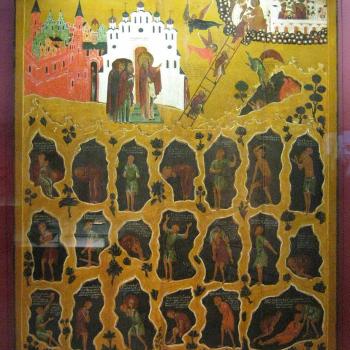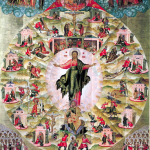
As a Catholic poet, I was excited to read this article about why the Catholic Church desperately needs artists, and was particularly taken with Pope Saint John Paul II’s reference to art as an evocation of our “nostalgia for God.” But as I kept reading, I felt something was missing, and this something was the question of what to do when art is dark.
It’s great to talk about the role of beauty in our communication and evangelism as a church. This has been important for centuries. But I can’t help wondering if the relationship between faith and art might not be a bit more complicated than a mere adoption of beauty to complement our truth.
Art isn’t simply a matter of ornamentation for use as a means of “selling” a particular message. It’s an attempted encounter with reality, something I would call integrity. Beauty can, of course, participate in such integrity, and in matters the Catholic News Agency article addresses, such as bulletin design. We need only look to the illumination of monastic manuscripts to know this. However, I worry lest Christian art be reduced merely to a kind of vehicular complement to a truth that can stand alone otherwise. This neglects art’s exploratory role, its ability to navigate spaces not quite the spheres proper of theology or philosophy or psychology or anthropology etc., while also – like Christ’s own incarnation – touching on these things.
Let me put it another way: I’m most drawn to art – whether my own or that of others – because it is a space that allows me to wrestle with things. The things I wrestle with are various, sometimes involving faith and sometimes not; topics may include mental illness; difficult aspects of belief and practice; apparent contradictions in Scripture, tradition and experience; tensions of emotion and reason; and some of the more challenging exemplars in our litany of saints. But I’m always wrestling – in the language of faith or not – with a particular integrity to the way the world is.
The perspective required to maintain this view of art is different from a perspective that sees beauty as merely a means of promulgating truth. The latter view suggests that art and aesthetic beauty are like sugar coating on the pill of doctrine and truth, while the former sees art not as the sugar that helps the medicine go down but rather as an essential part of the human digestive system. It doesn’t add any more truth to our faith and experience than the digestive system adds vitamins to vegetables, but it’s nonetheless integral if we are to digest and profit from the truth. Art is (at least ideally) a way of synthesizing the reality around us – all of it, sacred and secular – in a way that maintains integrity amidst apparently incongruous jags.
But such an approach to art and faith requires an attitude of humility that is exactly the opposite of a certain kind of exuberant call for the revivification of Catholic art. I’m thinking of those who would cleanse an awkward, ugly church of its embarrassing fashion choices, not unlike the fashionistas in a reality TV makeover show. Because our faith is not a faith of the elite only, there will always be a certain amount of ugliness and bad taste in the church – that’s what happens when you invite people from the highways and hedges. The church is as much theirs to contribute to as anyone’s. It’s why the lives of the saints are almost always a tangled mess of legend and truth and an endless source of frustration to both the poet and the historical purist; it’s why I imagine that at whatever unrecorded moment Christian art sprung into the world, so did Christian kitsch.
It’s absurd to suggest that the church just needs professionals to come in and fix her art. I understand why Anthony Murray, quoted in the CNA article, suggests “good art is not produced by people that do it on the weekends as a part-time thing when they get around to it”; he’s countering the assumption that beauty doesn’t matter, that it isn’t worth the cost of hiring professionals. No, the paintings in the Sistine chapel didn’t come from the brush strokes of a volunteer artist on evenings and weekends. But some great Catholic works of art have and do. For instance, J. R. R. Tolkien’s Lord of the Rings, one of the greatest 20th Century novels and an indisputable masterpiece of Catholic art, came out of Tolkien’s “secret vice” of language invention, and among his mentors in philology he counted Joseph Wright and Henry Bradley, self-educated working class scholars whose roots were very far from the “official” scholarly upper class (see Tom Shippey’s “Myth in Modern Fantasy” at 1 hour and 12 minutes). Not that I think we should nurse dewy-eyed romantic tales of everyone writing Lord of the Rings on the weekend or picking up philology as a casual hobby – but I share the story because the reality I live in is more complicated than one that divides artists into professionals who always know what they’re doing with art and laypersons who don’t.
To add to the confusion, there’s not always a direct correlation between the kind of art we appreciate as artists and the kinds of things that move people toward the kingdom of God. Think of the dreadful house ornament that becomes the sacramental figure in Flannery O’Connor’s short story “The Artificial Nigger,” or the gaudy little chapel in which Charles Ryder discovers prayer in Brideshead Revisited. Neither of these examples should be used as a justification of a nihilistic “anything goes” openness to bad taste, but they might give us pause when we undertake to clean up the aesthetic of the church for the greater glory of God. Some of the very things we’d throw out of the Church may be part of the mystery by which she unfolds salvation. The Church will survive our failed attempts to fix her, as she always has. But our attempts to fix her will presumably not survive, or be at all successful, if we don’t work within her mystery.
When I first encountered St. John of the Cross’s poem on the dark night of the soul, and his subsequent commentary on it, I wondered just how pompous you’d have to be to take your own experience, make a poem of it, and then further comment on it as though it were holy scripture or tradition. But as I further explore Christian mystical tradition, particularly via Luigi Giussani and the Ignatian approach to life with God, I have begun to understand that this is what we mean by faith, the realization that particular parts of our historical lives (whether moments, spans, phases etc.) intersect in a particular way with the life of God, and that our vocations are a matter of contemplating, unfolding, expounding, and waiting on these intersections. In the case of St. John of the Cross, the saint encountered God so powerfully, yet in such a compact and poetic way, that it would take more than his own lifetime to understand it. By holding out the mystery of his experience, laden with meaning, in the rich streams of tradition, scripture and prayer, he was able to produce a poetry powerfully infused with the Christian spirituality that had given it life. I think of him when I think of the task of the Christian poet – prayerfully holding out these moments where meaning hides amidst other streams of reality. St. John of the Cross brings his darkness to the altar and prays over it. This is his Christian aesthetic.
I also cherish as a patron of my practice a much more earthy figure, a character from Flannery O’Connor’s short story “Greenleaf.” The Greenleafs are an embarrassment of a family. Among the many qualities that embarrass the main character, Mrs. May, is Mrs. Greenleaf’s practice of what she calls “prayer healing.” This involves clipping accounts of tragedies and evils out of newspapers, depositing them all in a little hole she digs for them in the woods, and then groaning over them in charismatic drama til she falls on the ground, overcome.
Absurd and excessive, yes. And perhaps not a thing to emulate literally. Yet there is something in this figure moaning and waving her arms over the sorrows of the world that reminds me of the act of writing poetry. When I studied this story, my instructor, Ralph Wood, suggested that Mrs. Greenleaf is O’Connor’s counter to Dostoyevsky’s Ivan Karamazov, who likewise collects such instances, but as a means of building a case against God for allowing such evils. Mrs. Greenleaf is not a sophisticate like Ivan, but she intuitively understands something that Ivan doesn’t. In the face of evil, there is another option than “turning in one’s ticket” as regards existence – there is prayer. I like to think of the poetry I write as making space for such prayer.
How do we practice poetry and art as Christians? There are many ways, and I’d be presumptuous to try to provide a definitive answer that works for all art forms and all persons. Still, I think one can do far worse than collecting the sorrows of the world in one place and groaning in prayer over them before the guarantor of reality, God. Yes, at times it has all the gracefulness of mud wrestling – but they say that in doing so, some have found themselves wrestling with angels unawares.
Karl Persson is a scholar of premodern literature and theology, and is a professor in the Literature and Language Departments at Signum University. In his spare time, he enjoys creative and freelance writing, and is a regular contributor to the Patheos Catholic Channel’s Inner Room, a blog focused on contemplative spirituality and the recovery of ancient Christian practices and social imaginaries.
















